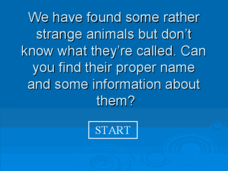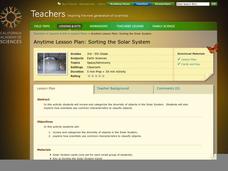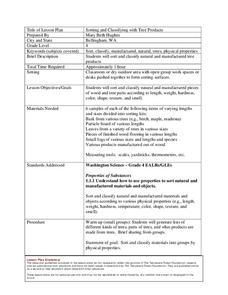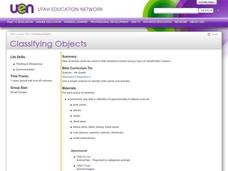Howard Hughes Medical Institute
Sorting Seashells
Scientists use morphological, physiological, and molecular information to continually revise organism classification. Scholars observe and learn about 20 shells. Then, they work to sort and classify the shells, building a taxonomy based...
Curated OER
Sorting Things Out
Written to examine seeds that grow in Kansas, you can adapt this lesson to anywhere you live. Learners sort a mixture of five different seeds to by any characteristic of their choice. When your budding scientists are exploring the life...
Curated OER
Classify Animals
Give your class an idea of how animals are classified by scientists with this interactive PowerPoint activity. They are presented with six different animals, they answer yes or no questions until only one animal remains alongside...
American Chemical Society
Classifying Objects Based on their Observable Properties
Sorting objects by properties is a lesson plan in justification. Learners begin by studying different types of properties of materials, including those based on appearance and texture. They examine the properties of specific items and...
Curated OER
Sorting
Learners examine Library organization. In this logic lesson, students watch a Between the Lions episode and consider how the library has been organized. Learners each list their 3 favorite book titles and how they would classify them....
California Academy of Science
Sorting the Solar System
Scientists are always sorting and classifying objects based on their characteristics. In a hands-on learning activity, young space explorers work together to categorize solar system cards based on their properties. It is up to the...
Curated OER
Sorting and Classifying with Tree Products
Fourth graders sort and classify wood. In this sorting tree products lesson, 4th graders sort and classify tree parts and pieces of wood, both natural and manufactured according to their properties.
Curated OER
Sorting Living and Nonliving Objects
Third graders sort and classify objects. In this sorting lesson, 3rd graders sort small objects such as cereal or candy. Then, students classify and sort objects that are living or nonliving.
South Gloucestershire Council
Animal Classification: A Collaborative Sorting Activity for Key Stages 2 & 3
Introduce the logic behind a dichotomous key or administer a group performance assessment with a fun and challenging classification lesson. With explicit instructions for the teacher and for collaborative groups, as well as engaging...
Howard Hughes Medical Institute
Sorting Finch Species
Don't just tell your class about Darwin's finches ... show them! Sort some of science's most famous birds using an interactive lesson. Learners try their hand at classifying finches using song, sonogram, and beak appearance, as well as...
Curated OER
Sorting and Classifying Worksheet
In this sorting and classifying worksheet, students read the names of 12 animals and sort the animals into three groups based on a single characteristic. The groups will be of the student's own choice. Note: The names of the animals are...
Curated OER
Local Animal Sort
Students examine the concepts of sorting and classifying animal. They use familiar animals to determine the connections between physical characteristics and categorization.
Curated OER
Recycling Game ABC's and Sorting
Students participate in an ABC game based on recycling. In this recycling lesson, students sort objects into bins based on the first letter of each object. Students discuss the community and how to improve recycling.
Curated OER
Gummy Bear Sorting
Students demonstrate knowledge of sorting and classifying by color as they sort gummy bear candies.
Curated OER
Classifying Objects
Fourth graders work in small groups to sort and classify a variety of objects. They develop criteria for sorting and explain the characteristics they chose for classification. Groups record and share their classifications.
Curated OER
Hardware Sort
Students work in groups to sort and classify a variety of hardware materials commonly found in the store. Students discuss attributes and explain their reasoning for different classifications.
Curated OER
Sorting
Young scholars identify how objects can be sorted or classified for easy access. For this sorting activity, students will investigate how letters, numbers, and symbols are used in sorting and classifying.
Curated OER
What Is in a Rock?
Middle schoolers identify, sort, and classify mineral samples that make up a common rock.
Curated OER
Fruits and Vegetables
Here is a fun way to investigate fruits and vegetables. In this healthy diet and reading lesson plan, learners read and recite several poems about fruits and vegetables. They sort pictures and word cards with assorted names of fruits and...
Curated OER
Classifying Deep-Sea Organisms
Young scientists access the EARTH Web site in order to engage in this lesson life forms found in the ocean. Student groups of 3 - 4 choose one set of deep-sea organism images. The groups decide how they would classify their organisms and...
Pyro Innovations
Beach Exploration
Little ones will absolutely love this lesson. It's all about the beach and what they can find while sifting through the sand. A large bucket of sand filled with hidden items is brought into the classroom. Learners will discuss what kinds...
Jude Mphoweh
Vertebrates and Invertebrates
Spine or no spine? Vertebrate or invertebrate? Learners sort and classify a list of animals as vertebrates or invertebrates into a graphic organizer.
Curated OER
Classifying Rocks
A well-designed lesson plan on rock classification awaits you. In it, fifth graders are divided into groups. Each group is given a box of rocks which they must sort into two categories. They use the "Rock 'n Roll Rule," in making their...
Curated OER
Rocks, Gems, and Minerals
Fourth graders review by sorting and classifying minerals. They describe the composition of a mineral and use rules to classify that mineral. They complete a mineral scratch test and place the results in a table in the second activity.























